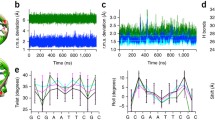Abstract
To design DNA nano-machines or analyze DNA molecular reactions, it is important to be able to predict the energy landscape of molecular structures and the energy barrier of a transition between structures on the landscape. Unfortunately, this is difficult for DNA molecules longer than 100 bases. In this paper, we propose an effective new technique for analyzing a structural transition over a DNA energy landscape. Imagine a very undulating landscape. Suddenly, water starts to gush out from one site and keeps flowing. How will the water surface expand over the landscape? Using a variant of Dijkstra’s and Jarník-Prim’s algorithms, we generate the shape of the basin from its formation process. The resulting basin contains the true energy barrier. Furthermore, a comparison between the basin feature and the corresponding actual chemical reaction shows that the basin can be used as a criterion to explain the reaction.
Preview
Unable to display preview. Download preview PDF.
Similar content being viewed by others
References
Ackermann, J., et al.: Word design for molecular information processing. Zeitschrift für Naturforschung 58a, 157–161 (2003)
Andronescu, M., et al.: RNAsoft: a suite of RNA secondary structure prediction and design software tools. Nucl. Acids. Res. 31, 3416–3422 (2003)
Andronescu, M., et al.: Algorithms for testing that sets of DNA words concatenate without secondary structure. In: Hagiya, M., Ohuchi, A. (eds.) DNA 2002. LNCS, vol. 2568, pp. 182–195. Springer, Heidelberg (2003)
Cupal, J., et al.: Density of States, Metastable States, and Saddle Points Exploring the Energy Landscape of an RNA Molecule. In: Proc. of 5th Int. Conference on Intelligent Systems for Molecular Biology (ISMB 1997), pp. 88–91 (1997)
Deaton, R., et al.: A Software Tool for Generating Non-crosshybridizing Libraries of DNA Oligonucleotides. In: Hagiya, M., Ohuchi, A. (eds.) DNA 2002. LNCS, vol. 2568, pp. 252–261. Springer, Heidelberg (2003)
Flamm, C., et al.: Barrier Trees of Degenerate Landscapes. Z. Phys. Chem. 216, 155–173 (2002)
Flamm, C., et al.: Design of multistable RNA molecules. RNA 7, 254–265 (2001)
Flamm, C., et al.: RNA folding at elementary step resolution. RNA 6, 325–338 (2000)
Flamm, C.: Kinetic Folding of RNA. PhD Thesis, University of Vienna, Austria (1998)
Fontana, W., et al.: Statistics of RNA secondary structures. Biopolymers 33, 1389–1404 (1993)
Hagiya, M.: Towards Molecular Programming. Modeling in Molecular Biology, Springer Natural Computing Series (2003) (in press)
Heitsch, C.E., et al.: From RNA Secondary Structure to Coding Theory: A Combinatorial Approach. In: Hagiya, M., Ohuchi, A. (eds.) DNA 2002. LNCS, vol. 2568, pp. 215–228. Springer, Heidelberg (2003)
Hofacker, I.L., et al.: Fast Folding and Comparison of RNA Secondary Structures. Monatshefte für Chemie 125, 167–188 (1994)
McCaskill, J.S.: The Equilibrium Partition Function and Base Pair Binding Probabilities for RNA Secondary Structure. Biopolymers 29, 1105–1119 (1990)
Morgan, S.R., et al.: Barrier heights between ground states in a model of RNA secondary structure. J. Phys. A: Math. Gen. 31, 3153–3170 (1998)
Kameda, A., et al.: Conformational addressing using the hairpin structure of single-strand DNA. In: Chen, J., Reif, J.H. (eds.) DNA 2003. LNCS, vol. 2943, pp. 219–224. Springer, Heidelberg (2004)
Kobayashi, S., et al.: An Algorithm for Testing Structure Freeness of Biomolecular Sequences. In: Jonoska, N., Păun, G., Rozenberg, G. (eds.) Aspects of Molecular Computing. LNCS, vol. 2950, pp. 266–277. Springer, Heidelberg (2003)
Kubota, M., et al.: Branching DNA Machines Based on Transitions of Hairpin Structures. In: Proc. of the 2003 Congress on Evolutionary Computation (CEC 2003), vol. 4, pp. 2542–2548 (2003)
SantaLucia Jr., J.: A unified view of polymer, dumbbell, and oligonucleotide DNA nearest-neighbor thermodynamics. Proc. Natl. Acad. Sci. USA 95, 1460–1465 (1998)
Stadler, P.F., et al.: Barrier Trees on Poset-Valued Landscapes. J. Gen. Prog. Evol. Machines 4, 7–20 (2003)
Tinoco Jr, I., et al.: Estimation of secondary structure in ribonucleic acids. Nature 230, 362–367 (1971)
Uejima, H., et al.: Secondary Structure Design of Multi-state DNA Machine Based on Sequential Structure Transitions. In: Chen, J., Reif, J.H. (eds.) DNA 2003. LNCS, vol. 2943, pp. 74–85. Springer, Heidelberg (2004)
Uejima, H., et al.: Analyzing Secondary Structure Transition Paths of DNA/RNA molecules. In: Chen, J., Reif, J.H. (eds.) DNA 2003. LNCS, vol. 2943, pp. 86–90. Springer, Heidelberg (2004)
Wuchty, S., et al.: Complete Suboptimal Folding of RNA and the Stability of Secondary Structures. Biopolymers 49, 145–165 (1999)
Yurke, B., et al.: A DNA-fuelled molecular machine made of DNA. Nature 406, 605–608 (2000)
Zuker, M., et al.: Optimal computer folding of large RNA sequences using thermodynamic and auxiliary information. Nucl. Acids. Res. 9, 133–148 (1981)
Author information
Authors and Affiliations
Editor information
Editors and Affiliations
Rights and permissions
Copyright information
© 2005 Springer-Verlag Berlin Heidelberg
About this paper
Cite this paper
Kubota, M., Hagiya, M. (2005). Minimum Basin Algorithm: An Effective Analysis Technique for DNA Energy Landscapes. In: Ferretti, C., Mauri, G., Zandron, C. (eds) DNA Computing. DNA 2004. Lecture Notes in Computer Science, vol 3384. Springer, Berlin, Heidelberg. https://doi.org/10.1007/11493785_18
Download citation
DOI: https://doi.org/10.1007/11493785_18
Publisher Name: Springer, Berlin, Heidelberg
Print ISBN: 978-3-540-26174-2
Online ISBN: 978-3-540-31844-6
eBook Packages: Computer ScienceComputer Science (R0)




